Floriculture and Horticulture in Haryana | HPSC Preparation: All subjects - HPSC (Haryana) PDF Download
Horticulture in Haryana
- Haryana is rapidly becoming a prominent player in the horticulture sector.
- The state cultivates a diverse range of fruits, vegetables, spices, mushrooms, and flowers.
- Approximately 85% of the horticulture cultivation area is dedicated to vegetables, while the remaining portion is allocated to fruits, spices, etc.
- The Economic Survey 2020-21 reports that the total horticulture cultivation area in the state is 4.78 lakh hectares, with a production of 80.67 lakh metric tonnes in 2019-20.
- In 1990-91, a separate Department of Horticulture was established by the government to stimulate the growth of horticulture.
The important horticultural crops like fruits, vegetables, spices, medicinal plants, aromatic plants and flowers are discussed in detail as follows:
Fruits
- In 2019-20, the total cultivated area for fruits in Haryana was 67,720 hectares, yielding a production of 11.97 lakh metric tonnes.
- The Department of Horticulture advocates a cluster approach to enhance the overall development of fruit cultivation.
- Key fruits cultivated in the state include mango, guava, papaya, kinnow, aamla, with Sirsa being the largest fruit-producing district and a significant contributor to orange, kinnow, and grape production. Sonipat leads in guava production, while Fatehabad takes the lead in apple and banana production.
Mango Cultivation
- Mango, the primary fruit cultivated in Haryana, covers over 19% of the total fruit cultivation area.
- Major mango varieties grown in Haryana include Dashehari, Chausa, Langra, Mallika, Ramkela, alongside newer varieties such as Arunika and Ambika.
- Yamunanagar is the leading mango producer in the state, followed by Ambala, Kurukshetra, Karnal, and Panchkula.
Kinnow Cultivation
- Kinnow cultivation is increasingly popular in Haryana due to its water-efficient nature, making it suitable for semi-arid regions of the state.
- The average Kinnow production in Haryana is 22 tonnes per hectare, and the cultivation area is expanding each year.
- Kinnow reaches the market from December to February, providing an extended harvesting and marketing period.
- The primary Kinnow-producing districts in Haryana are Sirsa, Fatehabad, Hisar, Bhiwani, and Jhajjar.
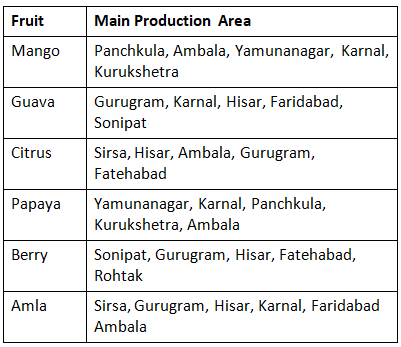
Vegetables
- In 2019-20, the total area dedicated to vegetable cultivation in Haryana was 397,295 hectares, yielding a production of 67.38 lakh metric tonnes.
- Key vegetables cultivated in Haryana include potato, cauliflower, carrot, tomato, radish, and onion, with potato being the most extensively grown.
- Sonipat takes the lead in vegetable production, contributing significantly to the state's overall vegetable output.
- Turnip cultivation is prevalent in Haryana and plays a role in improving land fertility.
Vegetables and Area of Production
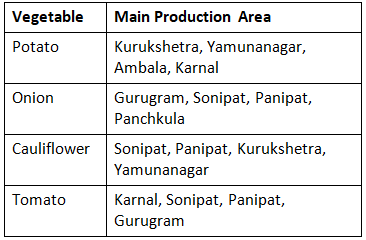
Top Producers of Fruits and Vegetables in Haryana
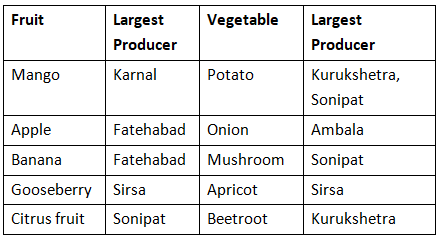
Spices
- Haryana cultivates various spices, including green chillies, garlic, coriander, methi, and turmeric.
- In 2019-20, the total area devoted to spice cultivation in Haryana was 9,660 hectares, resulting in a production of 0.79 lakh metric tonnes.
- Garlic stands out as the most extensively cultivated spice in Haryana.
- Yamunanagar district contributes significantly to spice production, accounting for approximately 40% of the total spice output in Haryana.
Area and Production of Spices
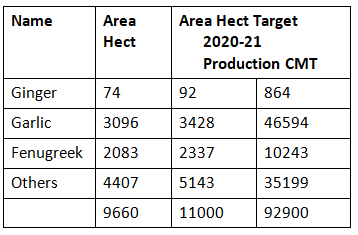
Spices and Area of Production
 Medicinal and Aromatic Plants
Medicinal and Aromatic Plants
Haryana state has a limited share in the cultivation of medicinal plants like Aloe vera, Stevia, Guggal, Tulsi, Mulethi, Arjun, Giloy, etc.
State Medicinal Plant Board
The establishment of the State Medicinal Plants Board on August 13, 2002, aimed to boost the medicinal and aromatic plants sector in the state. This involves executing promotional projects and schemes, as well as overseeing contractual farming initiatives supported and funded by the National Medicinal Plants Board.
- Medicinal plants contribute significantly to farmers' revenue.
- The State Medicinal Plant Board, situated in Panchkula, plays a crucial role by offering training, conducting workshops and seminars, and allocating resources for herbal parks.
- Aloe vera stands out as the most extensively cultivated medicinal plant in Haryana.
- Ongoing projects in the state include the 'Conservation and Development of Guggal' and 'Plantation of Amla and Moringa,' managed by the Forest Department.
- Haryana boasts 59 herbal parks, with Rewari having the highest count (15), followed by Mahendragarh (11). The development of the World Herbal Forest is underway in Morni Hills, and new parks are being established in Masudpur, Kheri Lohchab, Dharam Kheri, and Khanda Kheri.
Area and Production of Medicinal and Aromatic Plants
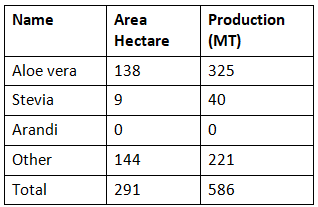
Floriculture in Haryana
- Mainly cultivated flowers in Haryana include Gladiolus, Marigold, Rose, and Tuber rose.
- According to the Economic Survey of 2020-21, the total flower cultivation area in 2019-20 was 3,478 hectares, with a production of 0.39 lakh metric tonnes.
- Gladiolus is the largest cultivated flower in Haryana, with Faridabad being the leading producer.
- The state is emphasizing the cultivation of Gerbera flowers in red, pink, yellow, and white colors, with plants sourced from Pune and Bengaluru.
- The Haryana State Government offers a 50% grant to farmers for Gerbera cultivation, considering its high demand for decoration in weddings and other ceremonies.
- Lilliam flowers in white, red, and yellow colors are in great demand, and their cultivation is concentrated in Tosham, Bhiwani district, leveraging the suitable sandy soil and climatic conditions.
- Lilliam seeds are imported from Holland.
- A center of excellence for flowers, established in collaboration with the Netherlands in Jhajjar district, aims to encourage farmers to take up floriculture.
- Shahbad town in Kurukshetra is gaining popularity for its lucrative flower cultivation, primarily of Marigold, Jaffrey Rose, and Chrysanthemum.
- Flowers from Haryana are supplied to Delhi, Chandigarh, Punjab, Himachal Pradesh, and Rajasthan.
Flowers and Area of Production
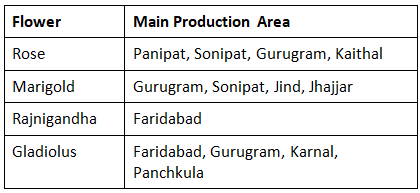
Crop Cluster Development Programme
- Initiated by the state's Horticulture department, this program was put into action on February 21, 2018.
- A total of 340 villages are selected for transformation into 'Horticulture villages,' organized into 140 clusters.
- These clusters are equipped with essential facilities such as packhouses, polyhouses, packing machinery, cold houses, primary processing units, sales centers, refrigerated vans, and solar energy facilities.
- Uncha Majra village in the Gurugram district serves as the pilot location for the development of this cluster.
Horticulture Vision 2030
- In 2017, the Haryana State Government outlined a long-term vision known as Horticulture Vision 2030.
- The objective of this vision is to double horticultural cultivation and triple production by the year 2030.
- To enhance the horticulture sector, the State Government has established Bagwani Vishwavidyalya in Karnal district.
- Under this initiative, the State Government is establishing Centers of Excellence in each district to promote horticulture, with Karnal, Sirsa, and Kurukshetra already having established three such centers.
- In alignment with this vision, the Haryana Government aims to increase the horticulture cultivation area from 7 to 25 percent.
Bhavantar Bharpayee Yojana:
- Launched on December 30, 2017, and effective from January 1, 2018.
- Farmers are guaranteed compensation if crop prices fall below specified levels.
- Aims to encourage farmers to shift from traditional crops to vegetables.
- Currently covers four vegetables: tomato, potato, onion, and cauliflower.
- First implemented in Ganger village, Karnal.
Horticulture University:
- To develop region-specific technologies addressing local needs, the State Government established Maharana Pratap Horticultural University in Karnal.
- The university commenced operations on January 6, 2017.
- Focuses on research in horticultural practices to benefit the state's agricultural landscape.
National Horticulture Mission:
- Launched by the Government of India in 2005-06 as a Centrally Sponsored Scheme.
- Aims to promote holistic growth in the horticulture sector through regionally differentiated strategies.
- Two granted schemes under the mission:
- Center for Excellence for food in Sirsa.
- Center for Excellence for vegetable in Karnal.
Indo-Israel Horticulture Project:
- The Haryana Government established the Indo-Israel Horticulture Project in Gharaunda, Karnal, enabling farmers to grow off-seasonal vegetables.
- The project involves preparing seedlings of various vegetables (e.g., tomato, seedless cucumber, capsicum) in greenhouse, polyhouse, and net house, with subsidized distribution to farmers.
International Horticulture Market:
- The Haryana Government plans to create a world-class wholesale fruit and vegetable trading platform using French expertise in horticulture marketing.
- The International Horticulture Market (IHM) is slated for development in Ganaur (Sonipat) and Panchkula.
Horticulture Insurance Schemes:
- Horticulture crops are included in the Pradhan Mantri Crop Insurance scheme.
- The State Government of Haryana introduces the Chief Minister Horticulture Insurance Scheme covering 20 crops (14 vegetables, two spices, four fruits).
Modified National Agricultural Insurance Scheme (MNAIS):
- Originally implemented in Karnal and Kaithal, now operational in Rohtak and Jind.
- Offers a grant of 40 to 50 percent.
- Wheat and rice crops are covered under this scheme.
Kisan E-Portal: The Horticulture Department in Haryana offers a service to connect villages with E-portals, allowing farmers to access information on weather, seed plantations, market rates, and other relevant details.
Farmer Clubs: Farmer clubs serve as grassroots-level informal forums led by individuals from the farming community. Currently, there are 835 such clubs operating in the state, each with a membership of 1000 farmers.
Technology Demonstration Centres: The State Government has established Technology Demonstration Centres at seven locations, namely Shamgarh, Gharounda, Mangeana, Ladwa, Ram Nagar, Jhajjar, and Bhuna.
Integrated Parasite Management:- To reduce reliance on chemical pesticides, the state has established a Biological Control Laboratory in Sirsa under this scheme.
- The State Government actively promotes bio-pesticides and bio-agents, leading to an increased adoption of bio-pesticides by farmers.
- As part of this initiative, farmers will receive free bio-agents to mitigate crop diseases and enhance integrated parasite management.
|
95 videos|318 docs|111 tests
|
FAQs on Floriculture and Horticulture in Haryana - HPSC Preparation: All subjects - HPSC (Haryana)
| 1. What is horticulture in Haryana? |  |
| 2. What is the significance of floriculture in Haryana? |  |
| 3. How does horticulture benefit the farmers of Haryana? |  |
| 4. What are the challenges faced by horticulturists in Haryana? |  |
| 5. How is the Haryana government supporting horticulture in the state? |  |















